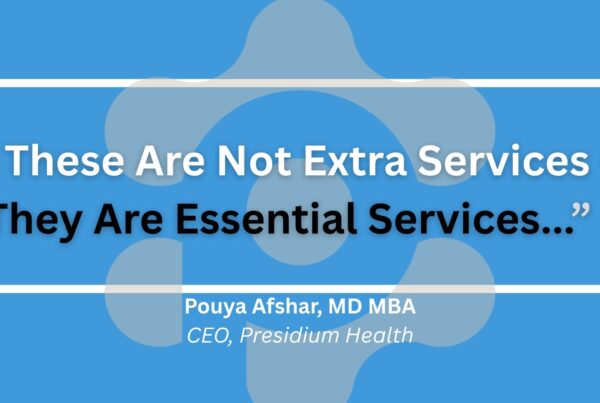Enhanced care management in California is reshaping how health plans address the needs of the state’s most vulnerable populations. As an essential strategy under initiatives like CalAIM, it aims to balance care quality with cost efficiency—yet the obstacles are significant. More detail around CalAIM’s framework guiding ECM can be found here. Administrative burdens, workforce recruitment, varied operational standards among managed care plans, and inability to find and engage members are key challenges.
Presidium Health is proving that tailored, home-based approaches can drastically reduce unnecessary hospital visits, saving millions and enhancing patient outcomes. It’s clear: overcoming these hurdles delivers not just better care, but also transformative savings for the healthcare systems.
Overview of Enhanced Care Management in CalAIM
Enhanced care management is a pivotal approach in modern healthcare that targets the most vulnerable groups with extra services, particularly those with complex medical and social needs. It reshapes traditional healthcare methods, bringing coordinated and comprehensive care into community settings, ensuring that the needs of these individuals are met in a more holistic and efficient manner. By focusing on coordination, support, and integrated services, enhanced care management is transforming the landscape of healthcare delivery in California. For more information about the service, explore our full ECM program guide.
Definition and Purpose
At its core, enhanced care management (ECM) is designed to cater to individuals with intricate health conditions. But what exactly does it entail? The Medi-Cal transformation fueled by ECM provides a whole-person approach, addressing both clinical and non-clinical needs. The key benefits of the Enhanced Care Management program are especially tailored for high-need populations enrolled in Medi-Cal and aims to provide inclusive support that spans beyond conventional medical management.
Key Components
What makes enhanced care management effective are its core service components, which are like the gears in a well-oiled machine. Here are some of the key components of ecm services:
- Personalized Care Plans: ECM revolves around creating care management plans that are as unique as the individuals they serve. These plans consider the person’s medical history, social needs, and future health goals.
- Integrated Services: It combines several services under one umbrella, including medical, behavioral, and social support. This means that management isn’t just about treating symptoms but addresses the individual’s overall well-being source.
- Community-Based Approach: Rather than pulling people into sterile clinical environments, ECM takes healthcare to the patient, whether that’s at home or in community centers.

Role of Technology in Enhanced Care Management
Technology isn’t just a part of enhanced care management; it’s the backbone that allows it to flourish. It provides the framework needed for effective care coordination and data sharing.
- Improved Care Coordination: Digital tools facilitate real-time communication among healthcare providers, ensuring everyone is on the same page.
- Data Sharing and Analysis: Through platforms that allow seamless data interchange, health practitioners can access comprehensive patient records, streamlining decisions and tracking patient progress with ease.
- Telehealth Services: Technology enables remote consultations, making it easier for patients to receive care without the need to travel.
- Innovation: Opportunities like the incentive payment plan (IPP) have opened up the opportunity for innovation in technology for service directed companies on the ground level.
With enhanced care management, the goal isn’t just to heal but to transform lives. By integrating technology with personalized services and a community-focused approach, ECM is a good step towards a smarter and more compassionate healthcare system in California.
What Are The Key Components of an Effective ECM Program?
An effective enhanced care management program comprises care coordination, patient engagement, data analytics, and proactive outreach of the populations of focus. These components work synergistically to improve patient outcomes, reduce healthcare costs, and enhance the overall quality of care provided by California health plans.
Challenges in Implementing Enhanced Care Management in California

Implementing ECM in California is not without its challenges. Despite its potential to improve patient outcomes, there are several roadblocks that stakeholders face. These issues can hinder the effectiveness of ECM and need to be addressed to ensure successful implementation across the state.
Administrative Burdens
The implementation of enhanced care management often involves a labyrinth of administrative tasks that can overwhelm providers and community-based organizations. Heavy paperwork and complex reporting requirements can stall progress and consume valuable resources. For example, managing diverse Medicaid requirements and ensuring compliance can be daunting. These challenges highlight the need for streamlined processes and support to reduce the burden on healthcare providers. Administrative burden issues are a significant hurdle that impacts the delivery of care.
Reimbursement Gaps
Financial challenges are another significant barrier in the implementation of ECM. California’s reimbursement rates often fall short of covering actual care costs, placing a financial strain on providers. This discrepancy, commonly referred to as reimbursement gaps, makes it difficult for healthcare providers to sustain quality care delivery. According to the California Health Care Foundation, systemic reimbursement shortfalls are pervasive, requiring urgent attention and reform.
Workforce Shortages

The shortage of skilled professionals remains a critical challenge in the field of enhanced care management. Recruiting and retaining qualified staff, such as case managers and clinicians, is increasingly difficult due to competition and geographic disparities. This issue is particularly pressing in underserved regions, where the need for ECM is greatest. Addressing these workforce shortages is essential for the effective delivery of enhanced care management.
Operational Inconsistencies Among Managed Care Plans
Managed care plans (MCPs) across California show significant operational inconsistencies, which complicate ECM efforts. Variations in processes, standards, and resource allocations can lead to uneven care delivery. Such inconsistencies often necessitate additional coordination and adaptation, resulting in delays and inefficiencies. Understanding the key issues with Medi-Cal managed care is crucial for stakeholders striving for uniformity in care management practices.
Capacity Building Needs
To effectively implement ECM, there is a pressing need for capacity building among providers. Developing a comprehensive understanding of available tools like social support services and available community resources is necessary for success. Training and resources are crucial to build confidence in handling complex care situations. This capacity-building process includes enhancing skills and adopting innovative care strategies tailored to patient needs. Initiatives like Capacity-Building Collaborative are essential for empowering providers and elevating their competency in ECM.
Inability To Find and Engage Members

One of the toughest challenges ECM providers face is the inability to find and effectively engage members in the population of focus. Once located, motivating these individuals to participate in care programs remains difficult. Cultural barriers, mistrust, and lack of awareness can hinder participation. Engagement strategies deployed by the care team need to be culturally sensitive and personalized to overcome these obstacles. Resources like Member outreach best practices provide valuable insights into successfully connecting with and engaging patients in enhanced care management programs.
Chief Operating Officer or Presidium Health, Melody Shedlosky notes ” this is a historically disenfranchised population, any outreach activity in this population needs to begin with that understanding… From a social justice perspective we want to help the people that need it most.”
Tackling these challenges requires a multifaceted approach, combining policy reform, innovative solutions, and collaborative efforts among all stakeholders involved in California’s healthcare landscape.
Case Study: Presidium Health
Presidium Health has been a trailblazer in the underserved, high-need population in California. “We’ve been pioneers in this type of care,” Shedlosky said. With over a decade of experience engaging and coordinating services for this cohort, Presidium Health is synonymous with ECM. Their strategies have not only saved money but also significantly improved patient outcomes. Learn more about provider strategies that overcome ECM challenges.
Pilot Programs and Outcomes
Presidium Health‘s pilot programs have made waves in California’s healthcare landscape. By targeting patients with the highest healthcare costs, their efforts revealed striking results:
- Hospitalization Reduction: Presidium’s approach led to a 53% reduction in hospitalizations among the highest-cost patients. This effort not only eased the burden on hospitals but also improved the quality of life for patients by allowing them to receive care in the comfort of their homes.
- Engagement: Presidium’s patient outreach feature, dubbed Operation Care , has been able to achieve unparalleled engagement in this population. With a find rate of 90% and 9 month engagement of 95% Operation Care has the ability to level the health access playing field.
- Cost Savings: These initiatives resulted in substantial savings. For instance, a single pilot program of 93 members saved about $6 million by reducing unnecessary hospital visits, showcasing the financial benefits of care coordination Presidium Expanding Cost-Saving Health Program.
Their success in these programs showcases how targeted healthcare investments can result in significant savings and better outcomes. This model can inspire health plan executives to rethink traditional approaches and explore innovative solutions.

Innovative Approaches
Presidium Health is recognized across California for its unique strategies that tackle the hurdles of enhanced care management. Here are some of their pioneering approaches:
- Home-based Care: Presidium Health ensures that patients receive care outside of hospital settings. By focusing on home-based services, they reduce hospital dependency and offer more personalized, accessible healthcare.
- Operation Care Find and Engage: Operation care is a set of outreach processes, extending from data searches to boots on the ground, that facilitate engagement of this disenfranchised cohort. The success speaks for itself with a 90% find rate and 95% 9 month engagement.
- Advanced Technology: Utilizing their proprietary STAT (Secure Text Activated Triage) platform, Presidium coordinates care on a large scale, efficiently managing patient care with technology that integrates seamlessly with their operations. Their use of local and national health information exchanges further enhances data access for comprehensive patient care.
- Integrated and Targeted Approach: Customized for high-need, underserved qualified members. Integrates management of health issues, social issues, and behavioral concerns including substance use disorder.
- 24/7 Access: Access, Access, Access. Presidium members have 24/7 access to Presidium Health.
These strategies underline that with the right tools and focus, healthcare can be more responsive and efficient, meeting patients where they are rather than relying on traditional in-office visits.
Community Support Initiatives
Complementing their enhanced care management are Presidium Health’s community support initiatives. These programs recognize that healthcare extends beyond medical treatments to incorporate various aspects of well-being:
- Social Services Integration: Presidium integrates social services into their healthcare model, addressing social determinants of health such as housing, finance, and transportation. This holistic approach ensures that patients receive comprehensive care that meets all their needs.
- Local Partnerships: Collaborating with local organizations allows Presidium to leverage existing community resources, creating a network of support for patients. These partnerships are crucial in providing additional services like food delivery, internet access, and personal fitness training.
- Transitions of Care: The epidemic of readmissions continues. Presidium’s data backed algorithms ensure members are contacted at critical points in their journey to minimize the possibility of readmission.
By integrating these community support initiatives, Presidium ensures that their patients are not just treated for their ailments, but are supported in living healthier, more fulfilling lives. This comprehensive care model emphasizes that true healthcare management involves addressing both medical needs and the broader life context of the patient.
Presidium Health’s enhanced care management model is a testament to the power of innovation in healthcare. Their success serves as a blueprint for how strategic investments and partnerships can revolutionize patient care, achieving better health outcomes and cost efficiencies. As healthcare continues to evolve, finding ways to implement such models on a broader scale could redefine care delivery across the nation.
Future Directions for Enhanced Care Management

The future of enhanced care management in California is ripe with opportunities to integrate more deeply with social services, rethink policy frameworks, and replicate successful models. With a focus on improving outcomes for patients, especially those with complex needs, these strategies aim to bring a holistic approach to healthcare. Enhanced care management is more than just a medical service; it’s a comprehensive system designed to address all aspects of a patient’s life.
Integration with Social Services
To truly address the social determinants of health, enhanced care management must weave more tightly with social services. This integration can help tackle issues like housing, nutrition, and mental health, which are pivotal for overall wellbeing. Imagine a world where a patient’s care plan includes not only medical appointments but also access to housing support and food security programs. By working together with social services, healthcare providers can offer a safety net that catches patients before they fall through the cracks.
- Housing Stability: Assisting patients in finding stable housing can reduce stress and lead to better health outcomes.
- Nutrition Support: Access to healthy food can prevent or manage chronic diseases like diabetes.
Mental Health Services: Integrating psychiatry and counseling can address emotional and psychological needs.
Policy Recommendations
For enhanced care management to thrive, policy changes are essential. Learn more about policy changes needed to remove ECM barriers. While current regulations sometimes hinder the seamless delivery of care. Here are some policy changes that could be transformative:
- Flexible Funding: Allow funds to be used for both medical and non-medical services that contribute to patient health.
- Data Sharing: Encourage easier sharing of patient data between healthcare providers and social services, protecting privacy without impeding care.
Incentives for Innovation: Provide financial incentives for healthcare organizations that develop successful integrated care models.
Scaling Successful Models
Successful models like those implemented by Presidium Health illustrate the power of effective ECM. Their approach, which has significantly reduced hospitalizations and costs, serves as a blueprint for others. Scaling these models involves understanding their core components and adapting them to different regions and populations.
- Localized Adaptation: Each community has unique needs; models must be flexible and adaptable.
- Technology Utilization: Leveraging platforms that streamline care coordination and patient engagement can simplify the implementation process.
- Training and Workforce Development: Developing a skilled workforce that understands the nuances of enhanced care management is crucial for scaling efforts.
- Member Outreach: Established outreach algorithms are critical in efficiently finding and engaging members.
By focusing on these areas, California can lead the way in providing comprehensive, patient-centered care. Enhanced care management holds the promise of transforming healthcare, ensuring that every aspect of a patient’s life is considered in their care plan.

Conclusion
Enhanced care management (ECM) in California presents both significant challenges and promising opportunities. The need for a robust workforce and streamlined administrative processes is critical to meet the demands. Pioneering models, like those implemented by Presidium Health, showcase how targeted care solutions can reduce unnecessary healthcare costs.
Emphasizing the importance of collaboration and continual innovation, stakeholders must focus on expanding proven systems while addressing care accessibility and equity. Health plan executives can lead this transformation by supporting initiatives that integrate social determinants of health into care strategies.
Continued progress relies on nurturing partnerships that prioritize patient-centric approaches, ultimately improving health outcomes and reducing costs. As California navigates these complexities, ECM remains a pivotal component in shaping future healthcare landscapes.



